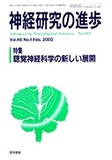Japanese
English
- 有料閲覧
- Abstract 文献概要
- 1ページ目 Look Inside
分子生物学的・発生工学的手法の進歩により,内耳の形態形成の分子機構が解明されつつある。耳胞の誘導には増殖因子のFGF3の関与が,また膜迷路の形態形成にはHoxalやkreislerなどの転写因子,およびFGF3の関与が示唆されている。また,感覚上皮領域に特異的に発現するBMP4などの分子が耳胞期の初期にすでに局所的に発現していることが明らかとなり,これを用いて感覚上皮領域の決定時期とその系譜の解析が進んでいる。内耳神経節細胞の生存には神経栄養因子のBDNFとNT-3が必要であることがノックアウトマウスの解析で示されている。さらに有毛細胞への分化の運命決定についてはNotchシグナル系の役割が注目されている。
一方,発生と関連して,高等脊椎動物である鳥類においては感覚上皮の傷害時に有毛細胞の再生がみられるばかりではなく,生理的条件下においても有毛細胞の持続的なturnoverが存在することが明らかとなった。これらの現象は発生期の有毛細胞産生とメカニズムを共有する可能性があることから,発生の研究が有毛細胞再生の分子機構の解明にも有用な情報をもたらすものと期待される。
The inner ear of all vertebrates originates from the otic placode, a thickened area of surface ectoderm adjacent to the hindbrain. During embryonic development, the otic placode invaginates to form a cup-like structure, which subsequently separates from the ectoderm to form the otocyst. The otocyst then gradually enlarges and undergoes remarkable changes in shape into the complex fluid-filled labyrinth, in which several distinct patches of sensory epithelia differentiate.

Copyright © 2002, Igaku-Shoin Ltd. All rights reserved.


